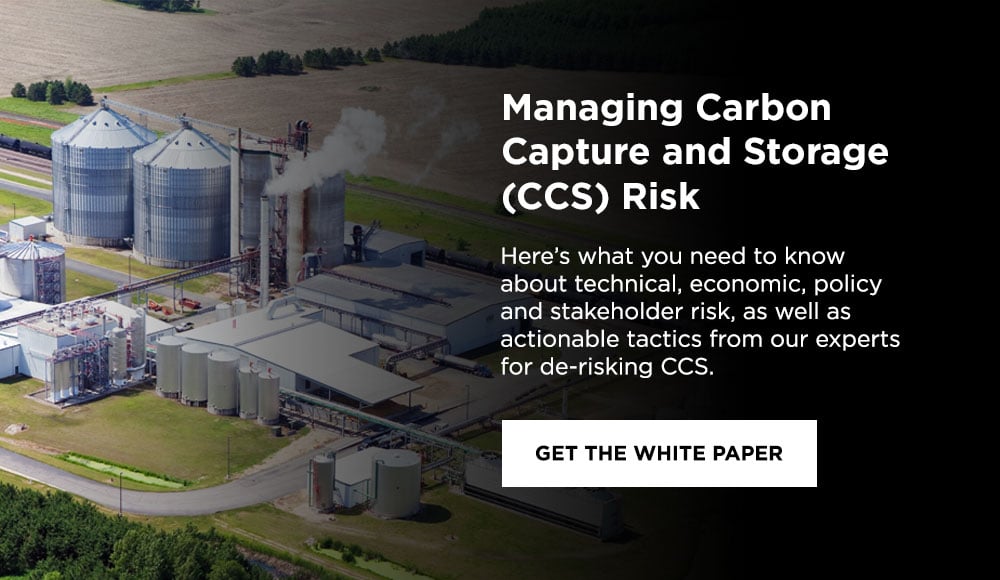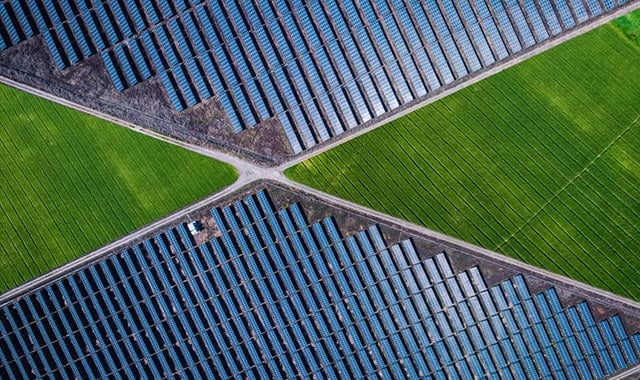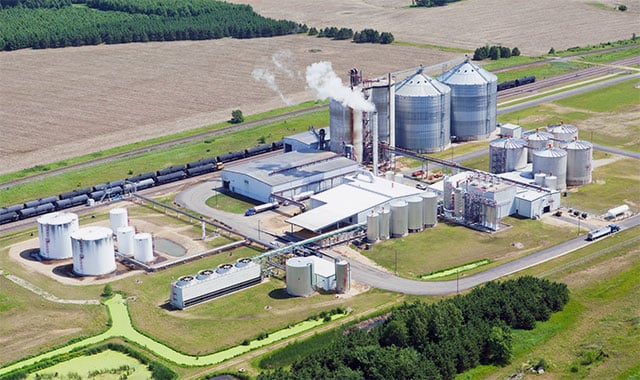Carbon Capture and Storage Risk Management from Capture to Closure

Just like any large-scale infrastructure project, carbon capture and storage (CCS) involves risk. However, implementing proactive risk management during each stage of CCS can put adopters on the path to a successful project outcome.
In this blog, learn how to understand and mitigate risk for each carbon storage phase, from selecting a CO2 capture site to safely closing it.
CCS Risk Management
What is CCS Risk Management?
CCS risk management refers to understanding and mitigating risk created by a carbon capture, utilization and storage (CCUS) project. Risk must be managed throughout the entire CCS process, across capture, transport, storage, and site closure.
For more information on CCS risk, read our blog "Understanding and Mitigating Carbon Capture and Storage (CCS) Risk".
Why Manage CCS Risk?
Integrated and methodical carbon storage risk management is essential to diminish uncertainty, bring clarity to risk profiles, and improve CCS project outcomes.
Download our white paper "Managing Carbon Capture and Storage (CCS) Risk" for need-to-know information on technical, economic, policy and stakeholder risk, as well as actionable tactics for de-risking CCS.
CCS Risk Management Across the Process
Each stage of a CCS project brings a different set of factors that have the potential to create risk. Whether you're a power plant operator, an ethanol producer, or an enhanced oil recovery (EOR) developer, enlisting a technical partner with deep expertise and experience in CO2 storage risk management can ensure the best outcome for your CCS project.
Keep reading to learn how to effectively manage risk during each stage of a geological storage project.
Stage 1: Site Selection
CCS site selection refers to choosing a location for injection and storage of CO2 (carbon dioxide). The captured carbon dioxide is typically injected into deep geological formations like saline aquifers or depleted oil and gas reservoirs.
Suitable CCS site selection is the bedrock of a successful CCS project and is crucial to reducing risk.
Have a potential CCS site in mind? Tap into our team's expertise at no cost - get a complimentary and confidential assessment of geological sequestration and operational viability here.
How Does It Work?
To determine the lowest-risk injection site, technical experts use advanced modeling methods like Static Earth Modeling and Numerical Reservoir Simulations to determine the lowest-risk injection site. These modeling methods allow for the evaluation of crucial factors such as CO2 storage capacity, stability, and containment reliability of the site.
Using these models, experts can predict CO2 behavior after injection, as well as find safe injection rates and total storage potential.
Risk Management During Site Selection
Ensuring appropriate geology for a CCS injection and storage location reduces risk by making sure requirements are met for factors like temperature, pressure, salinity, porosity and permeability.
A risk-optimized CO2 injection site will have the following elements:
A deep geological formation with permeability and porosity that is satisfactory for injecting CO2
A leak-proof layer of caprock to permanently seal the injected carbon dioxide inside
Minimal risk of potential CO2 leakage pathways or faults
Stage 2: Wellbore Drilling and Maintenance
In CCS, wellbore drilling and maintenance is the process of designing, drilling and maintaining a Class VI CO2 injection well. Proper injection well drilling and maintenance is essential to manage regulatory and safety risks.
How Does It Work?
Data collection and down-hole monitoring techniques are used by experts to inform well-drilling activities. Methods for data collection can include:
Wireline logging
Core rock sampling
Stratigraphic well testing
Experts use these techniques to verify the well's storage capacity, optimal injection rates and wellbore safety and stability.
Risk Management During Wellbore Drilling and Maintenance
High-quality wellbore drilling and maintenance helps manage CCS project risk stemming from rigorous United States Environmental Protection Agency Class VI permit requirements and safety protocols.
To manage CCS risk, successful injection well drilling and maintenance is compliant with:
- All regulations, including EPA Class VI guidance and more
- Well safety standards
- Injection well best practices
Stage 3: Injection
CCS injection refers to the process of injecting compressed carbon dioxide (CO2) into porous rock formations found deep underground.
Utilizing quality CO2 injection infrastructure and technical expertise minimizes risk arising from wellbore integrity and other factors.
How Does It Work?
In the injection phase of CCS, geological formations like saline reservoirs, coal seams or old oil reservoirs are filled with pressurized liquid CO2.
CCS experts use specialized sensors and logging instruments to ensure the carbon is securely and effectively sequestered.
Risk Management During Injection
Applying CCS best practices during the injection phase can mitigate risks related to CO2 leakage, plume movement and wellbore integrity.
To manage injection-related risk, operators utilize real-time measurement to ensure:
- Injected CO2 remains in a supercritical state to maximize storage potential and minimize potential leakage
- CO2 plume movement remains ideal
- Wellbore integrity breaches are quickly identified and handled
Stage 4: Monitoring, Reporting and Verification
Monitoring, reporting and verification (MRV) is an inclusive set of techniques intended to keep a CCUS project operationally and environmentally safe throughout the entire lifecycle.
How Does It Work?
CO2 storage monitoring, reporting and verification is crucial to remain compliant with stringent regulatory requirements and to qualify for CCS tax credits or incentives.
CCS experts use a variety of tools and technical capabilities throughout a project's lifetime to ensure successful outcomes, including direct measurements and indirect indicators.
Risk Management During Monitoring, Reporting and Verification
Expert monitoring, reporting and verification is a key component of CCUS risk management. MRV specifically reduces risk associated with environmental and operational factors.
Managing carbon capture and storage risk during the MRV stage should include:
- Constant monitoring of stored CO2 behavior
- Verification of CO2 storage volumes
- Prompt and transparent reporting of monitoring and verification data
Stage 5: Site Closure
Site closure of a CCS site is the process of discontinuing CO2 injection activities and ensuring the storage site is safe and stable for the long term.
How Does It Work?
To properly close a CCS site, several key steps must be completed by technical experts:
- Capping the injection well
- Confirming well cap integrity
- Long-term monitoring of plume movement
- Updating migration models with monitoring data
Risk Management During Site Closure
Completing a comprehensive CCS site closure is critical to managing risk arising from environmental changes. Carbon capture and storage risk management must remain top-of-mind even years after operations have ceased.
To minimize risk in the site closure phase, experts must safeguard against the following:
- CO2 leakage from the wellbore
- Unsafe CO2 plume migration
Your CCS Risk Management Partner
From navigating potential risks to implementing mitigation strategies, our team of 100+ CCS experts is here to help. We leverage an integrated and strategic risk management process to reduce uncertainty, ensure compliance and optimize project outcomes across the entire CCS value chain.
Count on our 25+ years of CO2 storage experience, comprehensive suite of CCS services and extensive subsurface and geotechnical knowledge to ensure your project's success.
Related Blogs
BATTELLE UPDATES
Receive updates from Battelle for an all-access pass to the incredible work of Battelle researchers.









